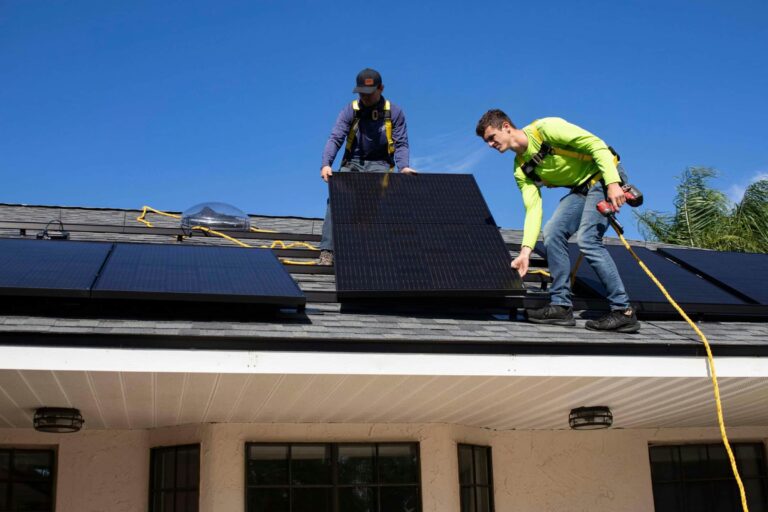ENVIRONMENT
Installing solar to boost your property value

WORDS: Caroline Russo PHOTOGRAPHY Supplied
If you’re in the market for a new home, or planning to sell, you may have noticed a new filter that has crept into home listings in recent years. Alongside filters for the number of bathrooms, bedrooms, living and car spaces, ‘solar panels’ have been added to the list of features.
It’s no wonder that having solar panels is a consideration for new home buyers, with sustainable attributes a critical consideration for 81% of buyers[1].
As one of the sunniest places in the world, it makes sense that Australian rooftops reap the rewards of an abundance of natural sunlight. Residential investment in solar and battery is continuing to rise across Australia, with the nation already a global leader in solar installations, with 3.6 million Aussie households already powering their homes with solar.
In fact, Queensland led the country in rooftop solar in 2023, with over one million small generation units installed. South East Queensland suburbs of Beenleigh and Logan Village, Ipswich and Toowoomba ranked in the top 10 solar suburbs last year with close to 32,000 solar households[2].
Solar energy, coupled with a home battery, can power cooking appliances, air conditioners, pool heaters, and your EV. It can even keep the lights on during extreme weather events when the rest of the neighbourhood waits in darkness.
Having the independence of using energy generated from solar panels and stored in a battery will save you money and of course, empowers homeowners to use their energy as they please without fear of energy bill shock.
But in addition to short term energy savings, investing in solar panels also adds value to your home. A recent survey revealed that every 1kW of solar installed can increase the value of a home by $6,000[3]. Plus, research has found that energy efficient homes are more likely to sell faster and at a premium price.[4
As it becomes increasingly difficult to predict trends within Australia’s ever-changing property market, investing in a home solar and battery system could be your ticket to commanding a higher sale price, while enjoying lower power bills in the meantime.
Australian solar, battery and energy specialists Nectr has shared advice about the things to consider when starting out with solar and battery for your home.
- Size and capacity: The number of people in the household and the average household energy usage will help identify the size of a solar system to suit the household’s energy needs. For instance, a person living on their own or a couple may suit a 6.6kW system with around 17 solar panels compared to a household with four or more occupants that would benefit from a 13.3kW system with around 34 solar panels. A government-backed Solar Consumer Guide can also help work out the best system for your household.
- Installation and warranties: Ensure solar panels are installed by a Clean Energy Council(CEC) approved installer and check product and performance warranties. Minimum 10-year product warranties and 25-year performance warranties are standard.
- Cost: The cost to install solar panels has decreased over the years and home battery costs are also showing signs of lowering. There are also government-led assistance schemes for eligible households for solar and battery installation, as well as state based programs such as those in NSW, VIC and ACT.
- Consider a battery: The solar panels will harness the power of the sun and the home battery will store this energy to power the fridge, washing machine, air conditioning at peak usage times for the household or at times when the sun is not shining. Household battery storage capacity is measured in kilowatt-hours (kWh). 1kWh is equal to one hour of electricity used at the power of 1kW. For example, using a 2000W oven for an hour would equate to using 2kWh of the battery’s capacity. As a comparison, a 200W TV would need to be used for 10 hours to add up to 2kWh. Generally, a typical home with solar panels exporting over 2MWh per year could meet its needs with battery systems of 5kWh through to 9kWh capacities.
- Join a VPP (Virtual Power Plant) network: For those with solar panels and a battery system, energy harnessed from the sun can fill a home battery. Connecting to a VPP network, such as that offered by Nectr, enables connected home battery systems to share energy back into the grid when it’s most needed. This helps provide a more reliable energy supply, and reduces the wastage of precious solar energy.
For more information visit www.nectr.com.au
[1] https://www.realestate.com.au/news/buyers-willing-to-fork-out-more-for-green-friendly-homes-as-sustainability-becomes-the-norm/
[2] Postcodes with highest uptake of solar revealed – Ministerial Media Statements
[3] https://solaremporium.com.au/blog/do-solar-panels-increase-property-value/#:~:text=According%20to%20a%20survey%2C%20the,the%20value%20of%20your%20home.
[4] https://www.domain.com.au/news/sustainability-the-surprising-feature-that-could-fetch-you-an-extra-125000-when-you-sell-1147020/









